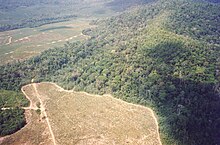Jari project
The Jari project was put into practice as part of the Projeto Calha Norte with the aim of redesigning the Amazon .
This project was run by the North American billionaire Daniel K. Ludwig in the 1970s. In 1967 he bought 16,000 square kilometers of virgin forest in Brazil on the Jari River . In parallel to these activities, the operating company began to plant eucalyptus , as these were fast-growing trees and a quick profit was expected from this. The first trees only needed a growth time of seven years and could practically be processed in the eighth year. Enthusiastic about these results, a jungle area the size of Belgium was cleared and planted with eucalyptus. Today visitors can still see the ecological consequences of this overexploitation in the large forest area. The soil became unusable in a short time (after 2-3 harvests) and the land became karst.
In 1978 he and his company built a cellulose factory in Japan and erected it on a floating pontoon directly in the jungle on the Jari River. For this factory transport on a floating pontoon, he used a novel technology that had been developed in Finland. Two platforms were made. The cellulose factory was delivered to one of them, the other contained an oil power plant (with wood pallet option) for 55 megawatts for the production of the necessary energy, because there was no separate energy source in this jungle area at that time. Cellulose production reached 200,000 tons as early as 1980.
Daniel Keith Ludwig had failed with his project and gave the Brazilian state the plantations and the associated factory as well as the now built Estrada de Ferro Jari railway line . It also left an environmental disaster as the chlorine-containing waste water from the factory was simply dumped into an artificial lake and there seeped into the groundwater. To date, this damage has not been repaired.
The Brazilian state transferred responsibility for the continuation of the project to the Caemi mining company . A long period of attempts to make eucalyptus planting in the tropical rainforest more ecological began. The saplings were changed through breeding, and the plantings were placed in the jungle in the form of round islands. Rest periods after a generation of trees have been harvested should regenerate the terrain. Nevertheless, the Jari project is still struggling to create an ideal form of symbiosis in the planting of eucalyptus trees for cellulose production and the preservation of the surrounding jungle. In 1992 cellulose production was already 280,000 tons.
The Jari project has now been expanded into a large industrial complex. Next to the cellulose factory is a factory for kaolin , which was found above ground on the other bank of the river. Another plant processes the raw material bauxite for onward transport. This raw material also mostly comes by train from a mine in the hinterland. The Caemi group has meanwhile been taken over by the Vale do Rio Doce mining group .
In 2000, the ORSA Group took over the Jari project and production was further increased. In the meantime, not only the eucalyptus forests in the area are processed in the factory, but also wood from other regions of Brazil, which is delivered by ship. In 2004, cellulose production reached a record 358,200 tons (an increase of 5% compared to 2003). The ORSA Group is trying to give paper production in the Amazon a green coat. Recycling projects at Brazilian schools have recently been funded by ORSA. It is claimed that the planting of eucalyptus in the rainforest is now under control and that cultivation is in harmony with nature. Since the demand for cellulose does not show itself evenly, but develops in bursts (pig-cicle), the factory production of Jari by ORSA has been shut down several times since 2008. A low point was reached in 2013 when ORSA's production was completely stopped. Production has been on the upswing again since 2018 and is to be expanded from 250,000 tons to 300,000 tons of pulp.
- items
- Loren Alexander McIntyre: Ludwig's dream. In: Geo-Magazin. Hamburg 1980, 8, pp. 80-100. Report on the billionaire Daniel Keith Ludwig's Jari project. ISSN 0342-8311
Individual evidence
- ↑ Jari Celulose SA - História ( Memento of the original from April 15, 2009 in the Internet Archive ) Info: The archive link was inserted automatically and has not yet been checked. Please check the original and archive link according to the instructions and then remove this notice.
- ↑ Jari Celulose SA - Projetos ( Memento from January 1, 2009 in the Internet Archive )
- ↑ Jari Celulose SA - Florestal ( Memento of April 29, 2009 in the Internet Archive )
- ↑ http://tribunadovaleblog.blogspot.com/2019/ Report of the local newspaper Tribuna do Vale on the Internet of February 11, 2019



